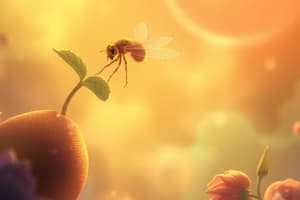Podcast
Questions and Answers
What is the name of the process where the sperm cell fuses with the egg?
What is the name of the process where the sperm cell fuses with the egg?
- Acrosome reaction (correct)
- Mitosis initiation
- Zygote formation
- Blastocyst development
What type of cell is formed when the sperm and egg fuse together?
What type of cell is formed when the sperm and egg fuse together?
- Gonad cell
- Gamete cell
- Diploid cell (correct)
- Haploid cell
Which factor plays a crucial role in determining the likelihood of fertilization?
Which factor plays a crucial role in determining the likelihood of fertilization?
- Egg color
- Blood type
- Sperm quality (correct)
- Hair length
Where is fertilization most likely to occur under normal circumstances?
Where is fertilization most likely to occur under normal circumstances?
During which phase is the zygote formed through the fusion of sperm and egg cells?
During which phase is the zygote formed through the fusion of sperm and egg cells?
What event triggers a series of chemical reactions leading to the activation of the egg during fertilization?
What event triggers a series of chemical reactions leading to the activation of the egg during fertilization?
What is the main event in the process of fertilization?
What is the main event in the process of fertilization?
Where does fertilization typically occur in the female reproductive system?
Where does fertilization typically occur in the female reproductive system?
What are the tiny cells produced in the male testes that combine with eggs during fertilization?
What are the tiny cells produced in the male testes that combine with eggs during fertilization?
Which part of the egg must sperm cells penetrate to reach the egg itself during fertilization?
Which part of the egg must sperm cells penetrate to reach the egg itself during fertilization?
What is the role of eggs (ova) in fertilization?
What is the role of eggs (ova) in fertilization?
How are sperm cells propelled through the male reproductive tract?
How are sperm cells propelled through the male reproductive tract?
Flashcards are hidden until you start studying
Study Notes
Reproduction: Exploring Fertilization
When we think about making new life, a process called fertilization lies at the heart of it all. Fertilization is the joining of sperm and egg, leading to the formation of a unique zygote, the first stage of a new organism's life. In this exploration of reproduction, we'll delve into the details of this remarkable event, examining the roles of sperm, egg, and the conditions that make fertilization possible.
The Players: Sperm and Egg
Sperm are tiny cells produced in the male testes. They contain 23 chromosomes and are propelled through the reproductive tract by their tails. A mature sperm cell is capable of combining with an egg to create a new life.
Eggs, also called ova, are produced in the female ovaries. They contain 23 chromosomes and are surrounded by a protective membrane called the zona pellucida. The egg is responsible for providing nourishment and protection for the developing embryo.
The Process: Fertilization
The process of fertilization occurs in the female reproductive tract, typically in the fallopian tubes. Here's a simplified account of what happens:
-
Sperm meet the egg. Sperm are released from the male during ejaculation and travel through the female reproductive tract. One or more sperm cells eventually reach the egg in the fallopian tube.
-
Sperm penetration. Sperm cells must penetrate the egg's outer layer, the zona pellucida, to reach the egg itself. This is facilitated by enzymes called acrosomes, which are released upon contact with the zona pellucida.
-
Sperm-egg fusion. One sperm cell fuses with the egg, initiating a series of chemical reactions that result in the activation of the egg. This process is called the acrosome reaction.
-
Fusion of haploid cells. The sperm cell and egg cell each contain 23 chromosomes, making them haploid cells. When they fuse, they form a diploid cell containing 46 chromosomes (23 from each parent). This cell is called a zygote.
-
Division and development. The zygote divides repeatedly through a process called mitosis, forming a ball of cells called a blastocyst. The blastocyst eventually implants in the uterine wall, where it will continue to grow and develop into a new organism.
Factors Influencing Fertilization
Several factors can influence the success of fertilization:
-
Sperm quality. The number and quality of sperm cells can impact the likelihood of fertilization. Damaged or abnormal sperm cells may have difficulty reaching or penetrating the egg.
-
Egg quality. The health of the egg and its ability to become fertilized and develop properly is a crucial factor in the reproductive process.
-
Timing. Fertilization is most likely to occur during ovulation, when the egg is released from the ovary and remains in the fallopian tube for approximately 24 hours.
-
Location. Fertilization typically occurs in the fallopian tubes, but can also occur in the uterus or cervix under certain circumstances.
Understanding fertilization and its various factors is essential to our knowledge of human reproduction. This understanding can help us make informed decisions about family planning, fertility treatments, and the broader field of reproductive science.
Sources:
Studying That Suits You
Use AI to generate personalized quizzes and flashcards to suit your learning preferences.



